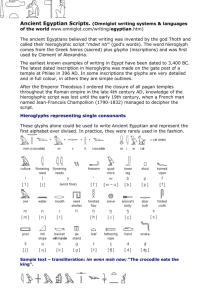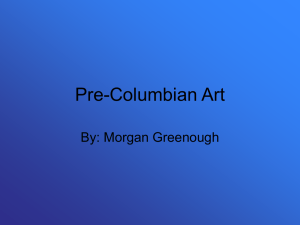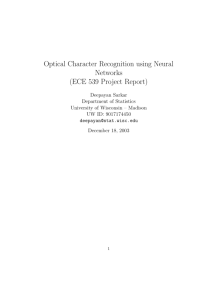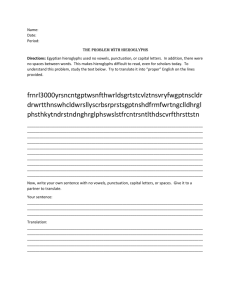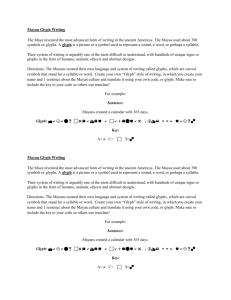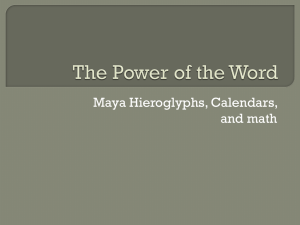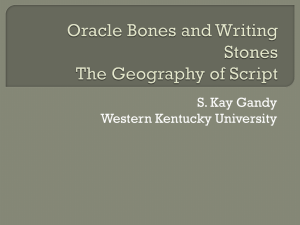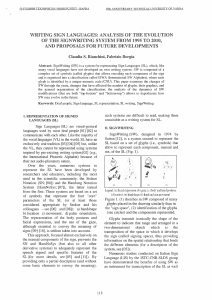Presentation
advertisement
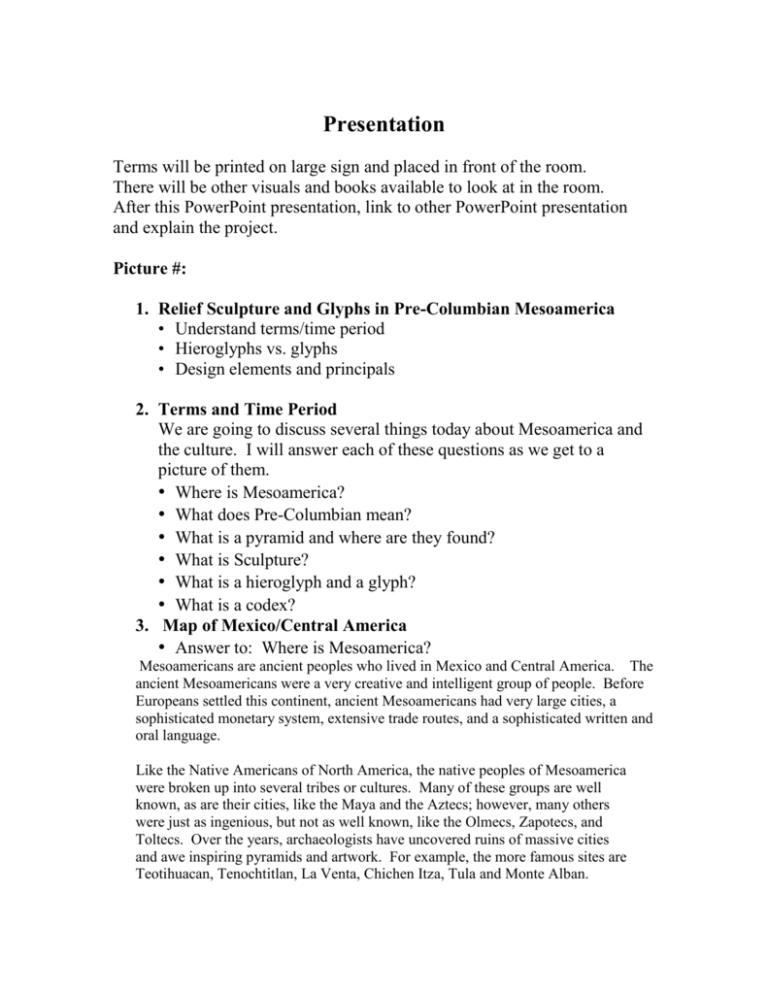
Presentation Terms will be printed on large sign and placed in front of the room. There will be other visuals and books available to look at in the room. After this PowerPoint presentation, link to other PowerPoint presentation and explain the project. Picture #: 1. Relief Sculpture and Glyphs in Pre-Columbian Mesoamerica • Understand terms/time period • Hieroglyphs vs. glyphs • Design elements and principals 2. Terms and Time Period We are going to discuss several things today about Mesoamerica and the culture. I will answer each of these questions as we get to a picture of them. • Where is Mesoamerica? • What does Pre-Columbian mean? • What is a pyramid and where are they found? • What is Sculpture? • What is a hieroglyph and a glyph? • What is a codex? 3. Map of Mexico/Central America • Answer to: Where is Mesoamerica? Mesoamericans are ancient peoples who lived in Mexico and Central America. The ancient Mesoamericans were a very creative and intelligent group of people. Before Europeans settled this continent, ancient Mesoamericans had very large cities, a sophisticated monetary system, extensive trade routes, and a sophisticated written and oral language. Like the Native Americans of North America, the native peoples of Mesoamerica were broken up into several tribes or cultures. Many of these groups are well known, as are their cities, like the Maya and the Aztecs; however, many others were just as ingenious, but not as well known, like the Olmecs, Zapotecs, and Toltecs. Over the years, archaeologists have uncovered ruins of massive cities and awe inspiring pyramids and artwork. For example, the more famous sites are Teotihuacan, Tenochtitlan, La Venta, Chichen Itza, Tula and Monte Alban. • Answer to: What does Pre-Columbian mean? Hundreds of years ago, before Columbus came to this land in 1519. 4. Picture of Egypt’s Pyramids Picture: Pyramids of Egypt. Question: Where do you think this is? Define Pyramid: a structure with a square base and triangular sides; used in ancient Egypt as tombs and in Mesoamerica for religious rites. 5. Picture: Pyramids of Chichen Itza. Question: Where do you think this is? What is different about this pyramid than the other we just saw? 6. Toltec Statues What are these? Where do you think they are? Define: Sculpture: a work of art that is meant to be viewed from all sides; a work of art that is three-dimensional. It can be carved in stone or wood, modeled from clay or plaster or cast in metal. Define: 3-D: a work of art that is meant to be viewed from all sides; having the dimensions of depth as well as width and height. Define: 2-D: a work of art that is flat and viewed from the front, like a painting - having the dimensions of width and height only. 7. Picture: Quetzalcoatl. Question: Was this carved the same way as the Toltec Statues? What is different about this? 8. Stella from Bonampak Question: What do you think this is? Define: Stella: a freestanding sculpture carved in stone or basalt. Define: glyphs: picture symbols and pictographs, symbols in which objects were represented by a miniature, often stylized, drawing. Go to picture of Yaxchilan Lintel 45 to show how detailed it can be 9. Lintel from Yaxchilan 10. Picture of hieroglyphs and glyphs Picture: Hieroglyphs. Question: What is this? What country do you think this came from? Picture: Glyphs. Question: What is this? What country do you think this came from? Define: hieroglyphs and compare to glyphs: Ancient Egyptian writing. At first picture signs were used to represent objects. Later, the signs came to represent sounds as well. 11. Picture of the codex Define codex: an Aztec picture book made from tree bark, cloth, or deerskin, which was then folded back and forth in a zigzag manner. Scribes attached thin pieces of wood at the ends of the strip, which formed covers that protected the pages. Most codices were read from top to bottom, some were read around the page. The whole codex was read from left to right. The scribes, who were very educated and artistic men, made these books. Important information was recorded in these books by using glyphs, or picture symbols; important things like history, calendars, religious information, population and tax information, as well as information about daily life. Certain features were general for each of these codices; for example, there was a ‘ground’ area, a ‘sky’ area, smaller figures were placed farther away and toward the top to indicate distance, and the more important the figure, the larger they were. Not only were glyphs written in books, but they were also carved on stone. Types of stone included: limestone and sandstone. Not only that, but they were painted on walls, using paints made from minerals and plants. They had many ideas for their glyphs, including those found in nature like, snakes, jaguars, bats, birds, humans, and spider monkeys. They also had quite an imagination, thus creating supernatural and cosmic style glyphs. 12.Picture:Yaxchilan Lintel 45. Question: What do you think is happening in this picture? What is the mother doing? What is the son doing? Go back to stella to show again how it really looks 13. Picture of colored glyphs, painting on a wall using tempra 14. Pictures of real jaguars explain how they liked to use animals in their carvings 15.Picture: Jaguar (realistic). Question: What animal is this? How can you tell, what defining features does it have? How do you think this animal is portrayed, realistic or stylized? a. Define Realistic: life-like 16. Picture: Jaguar (stylized). Question: How do you think this animal is portrayed, realistic or stylized? How do you think this was carved and what was it carved on? Define Stylized: not life-like, but a form that represents something real Go to other powerpoint presentation and explain project
